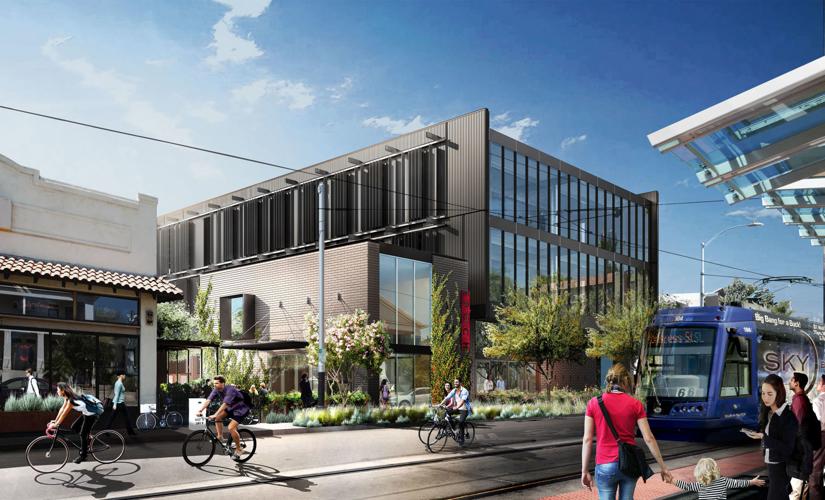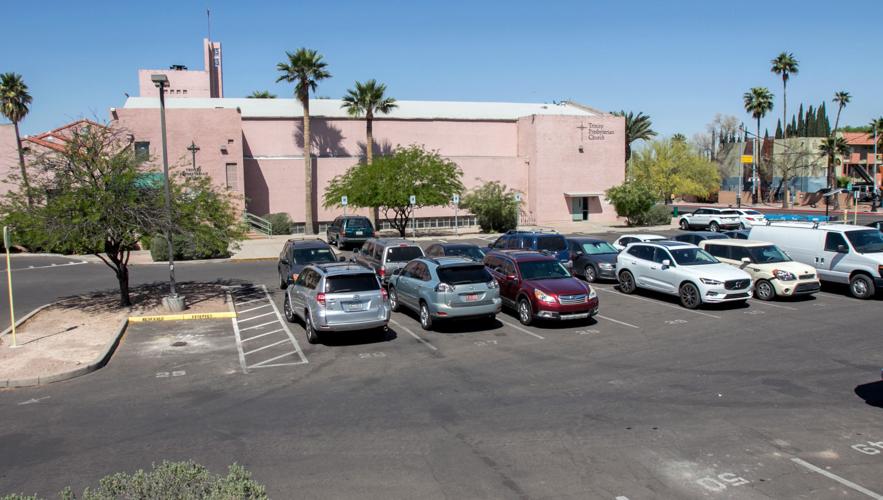After more than seven years of discussions with and concessions to area stakeholders, local developers are moving forward with a project that will bring new apartments, office space and retail to Tucson’s Fourth Avenue and University Boulevard.
The development, dubbed The Trinity, will sit on two sides of Trinity Presbyterian Church, 400 E. University Blvd., on excess land the church is selling.
The first phase of the project will be construction of a three-story office building along University Boulevard, between the church and Time Market, said Randi Dorman, with R+R Develop. She and her husband, architect Rob Paulus, are developing the project along with Bourn Cos.
The second phase will be a four-story residential building, south of the church on Fourth Avenue with 58 market-rate apartments, ground-floor retail and sidewalk dining. That space is currently occupied by a structure, also owned by the church, that is not being used or historic. It will be demolished.
“We just fell in love with this location,” Dorman said. “So much could be successful there, it’s the perfect location.”
She said the ideal office user will be one that “values 20- and 30-year-olds who want to take the streetcar to work.”
The project will include a pocket park along Fourth Avenue.
“The impact of revitalization has been profound,” Dorman said. “When people can bump into each other and exchange ideas it is more impactful than when we have urban sprawl.”
Given the pushback from area residents and merchants about new construction on Fourth Avenue, Trinity developers turned to neighbors for ideas about design right from the start and elicited their help in getting one more story of height, bringing it to 50 feet, for the apartment complex.
“We had 19 neighborhood meetings,” Dorman said. “We’re very sensitive and have developed the plan all along with them.”
The church’s congregation was especially active, she said.
Bucky Lovejoy, chairman of the long-range development committee for Trinity Presbyterian Church, said the pastors and congregation put out a request-for-proposals in 2011 to see what ideas would come about if the church sold the excess land that it no longer used.
Four developers responded and the church chose R+R and Bourn because of their reputation.
“The congregation was supportive because they had a chance to voice their opinion on the whole thing all along,” Lovejoy said. “It took two years to approve it.”
While not without some dissent, area residents were mostly supportive because of how developers engaged them, said Johnny Birkinbine, a board member of the West University Historic Zone Advisory Board and a property owner in West University.
“At the early stages of the project, before design, the architect took the time to study and understand the existing historic context surrounding the project site, as well as appropriate design for the desert environment — something rarely seen in development projects,” he said. “Height was favored over a larger building footprint on the site to provide an enhanced open and active pedestrian-friendly experience at the street level.”
The sale for the parcel on University Boulevard is scheduled to close April 30 and developers plan to break ground in the fall, with construction expected to take between 12 and 18 months.
GROWING PAINS
Two other residential-retail projects recently announced along Fourth Avenue have been met with angst by some residents and merchants, who have packed City Council meetings to voice their opposition.
One is a seven-story complex on Fourth Avenue on the site of the Flycatcher and the other a 14-story complex on the south end of Fourth Avenue, where Maloney’s is now housed.
“It all begins with the streetcar,” said Michael Laatsch, a commercial broker with CBRE, who has inked many deals on Fourth Avenue and downtown. “That investment put Tucson on the radar for investors outside the market.”
Fourth Avenue, in particular, is appealing because it connects the University of Arizona and downtown.
“It’s inevitable that it’s going to be developed with higher density,” he said. “This is growing pains.”
He agreed that how developers approach neighbors and business owners is critical.
“It’s responsible for the developers to engage the neighborhoods very early in the process — no one likes surprises,” Laatsch said. “Being a downtown enthusiast myself, I appreciate the funkiness and uniqueness and I don’t want to see that go away either, but if we’re going to keep up as a market, we need to provide the type of housing and lifestyle options that young professionals are looking for.”
He said nationwide there is a demographic shift toward urbanization, walkable lifestyles and sense-of-place living.
“Most months of the year, our weather lends itself to the walkable lifestyle,” Laatsch said. “No one is going to get frostbite.”





